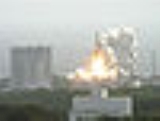
Yoshinobu Launch Complex
Encyclopedia
The Yoshinobu Launch Complex, also known as Launch Area Y, Area Y or LA-Y, is a launch complex at the Tanegashima Space Centre
, used by the H-II
and H-IIA
carrier rockets. The complex is also used by the H-IIB
, which was first launched on 10 September 2009. That flight launched the HTV-1
spacecraft to resupply the International Space Station
.
It is the most Northern launch complex at Tanegashima, and along with the now inactive Osaki Launch Complex, it is part of the Osaki Range, used for orbital launches. The Yoshinbou complex consists of two launch pad
s, however launches have only been conducted from pad 1, which was built around 1993 for the H-II programme. The second pad was completed around 2000, shortly after the H-II was retired in favour of the H-IIA, but is yet to be used for a launch. The complex also contains a test stand for firing the LE-7
engines used in the first stage of the H-II and its derivatives. Prior to launch, rockets are processed vertically in the complex's vehicle assembly building. The rocket is rolled out to the launch pad on a mobile launch platform about twelve hours before it is scheduled to launch. It takes around thirty minutes to transport the rocket from the assembly building to Pad 1.
Tanegashima Space Center
The is one of Japan's space development facilities. It is located on Tanegashima, an island located 115 km south of Kyūshū. It was established in 1969 when the National Space Development Agency of Japan was formed...
, used by the H-II
H-II
The H-II rocket was a Japanese satellite launch system, which flew seven times between 1994 and 1999, with five successes. It was developed by NASDA in order to give Japan a capability to launch larger satellites in the 1990s. It was the first two-stage liquid-fuelled rocket Japan made using only...
and H-IIA
H-IIA
H-IIA is an active expendable launch system operated by Mitsubishi Heavy Industries for the Japan Aerospace Exploration Agency . The liquid-fueled H-IIA rockets have been used to launch satellites into geostationary orbit, to launch a lunar orbiting spacecraft, and to launch an interplanetary...
carrier rockets. The complex is also used by the H-IIB
H-IIB
H-IIB is an expendable launch system used to launch H-II Transfer Vehicles towards the International Space Station. H-IIB rockets are liquid-fuelled with solid-fuel strap-on boosters and are launched from the Tanegashima Space Center in Japan...
, which was first launched on 10 September 2009. That flight launched the HTV-1
HTV-1
HTV-1, also known as the HTV Demonstration Flight or HTV Technical Demonstration Vehicle, was the first Japanese Space Agency H-II Transfer Vehicle, launched in September 2009 to resupply the International Space Station and support the JAXA Kibo laboratory or JEM...
spacecraft to resupply the International Space Station
International Space Station
The International Space Station is a habitable, artificial satellite in low Earth orbit. The ISS follows the Salyut, Almaz, Cosmos, Skylab, and Mir space stations, as the 11th space station launched, not including the Genesis I and II prototypes...
.
It is the most Northern launch complex at Tanegashima, and along with the now inactive Osaki Launch Complex, it is part of the Osaki Range, used for orbital launches. The Yoshinbou complex consists of two launch pad
Launch pad
A launch pad is the area and facilities where rockets or spacecraft lift off. A spaceport can contain one or many launch pads. A typical launch pad consists of the service and umbilical structures. The service structure provides an access platform to inspect the launch vehicle prior to launch....
s, however launches have only been conducted from pad 1, which was built around 1993 for the H-II programme. The second pad was completed around 2000, shortly after the H-II was retired in favour of the H-IIA, but is yet to be used for a launch. The complex also contains a test stand for firing the LE-7
LE-7
The LE-7 and its succeeding upgrade model the LE-7A are staged combustion cycle LH2/LOX liquid rocket engines produced in Japan for the H-II series of launch vehicles...
engines used in the first stage of the H-II and its derivatives. Prior to launch, rockets are processed vertically in the complex's vehicle assembly building. The rocket is rolled out to the launch pad on a mobile launch platform about twelve hours before it is scheduled to launch. It takes around thirty minutes to transport the rocket from the assembly building to Pad 1.

